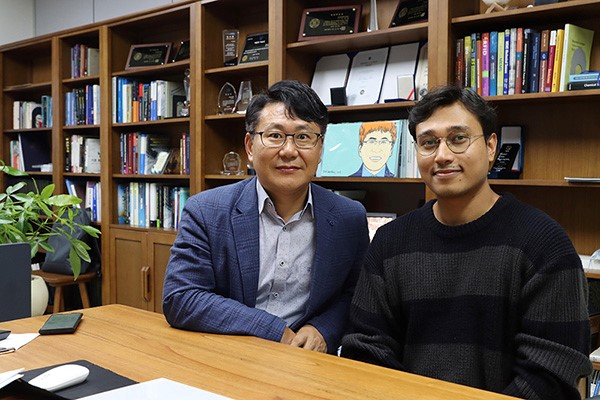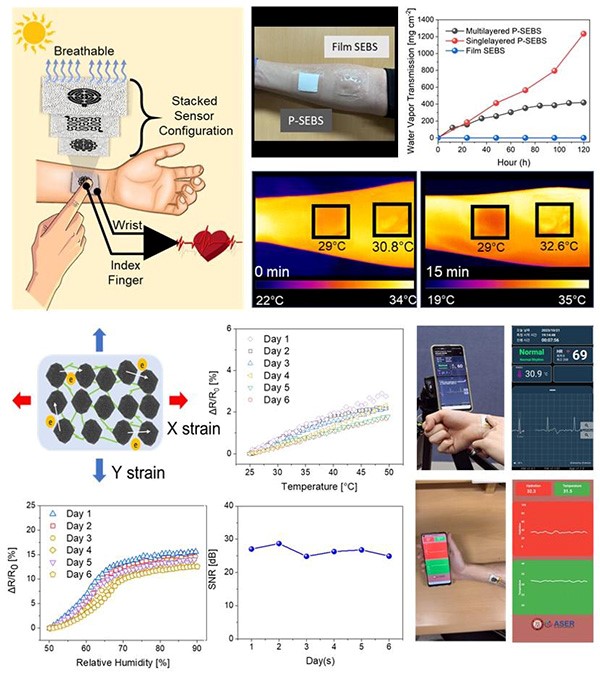Prof. Jaeyoung Park’s Team Develops Breathable Patch for ECG, Temperature, and Moisture Monitoring
- admin
- 2024-11-11
- 79
Professor Jaeyoung Park’s Research Team (Department of Electronic Engineering)
Develops Miniature Breathable Patch Capable of Monitoring ECG, Skin
Temperature, and Moisture Levels
- Development of a miniature breathable patch for
remote monitoring of skin temperature, moisture levels, and ECG -
- Expected to serve as a core technology for smart medical/healthcare,
robotics, sports, fitness, and artificial organs -
- Published in the internationally renowned journal Advanced
Functional Materials by Wiley (IF: 18.5) -
Professor Jaeyoung Park's research team from
the Department of Electronic Engineering has successfully developed a miniature
electronic skin patch capable of real-time, continuous monitoring of ECG, skin
temperature, and moisture levels. The patch is designed to prevent interference
between sensors and to maintain consistent performance under multi-directional
external deformations. Additionally, it features a breathable structure that
facilitates heat dissipation and sweat evaporation at the skin-sensor
interface. By simplifying the manufacturing process and using a layered
structure, the team achieved miniaturization of the patch, increasing its
potential for mass production and commercialization.

<Professor Jaeyoung Park (left) and Ph.D. candidate Gagan
(right)>
Recently, research on wearable digital healthcare and medical Internet
of Things (IoT) applications has actively progressed, focusing on integrating
multiple sensors into a single flexible substrate to measure and monitor various
biometric signals. However, this approach typically requires a large substrate
area, limiting reliability due to performance constraints such as signal
interference between sensors. In this study, the electrode structure was
designed to resist external deformation impacts, and a layered structure was
applied to miniaturize the device without mutual interference between sensors,
thereby enhancing the performance and reliability of the patch sensor.
Additionally, by layering multiple sensors onto a porous, hydrophobic,
stretchable substrate, a breathable electronic skin patch was created.
A hierarchical porous network was created by using spray-coated
styrene-ethylene-butylene-styrene (SEBS) as the substrate and applying phase
separation. Carbon nanotubes and nanoporous carbon (CNT@NPC) ink were deposited
onto the SEBS substrate using a pattern mask designed to be
deformation-insensitive, thereby forming the electrodes for the sensors. The
porous structure not only enhances breathability but also ensures a strong bond
between the CNT@NPC sensing elements and the SEBS substrate due to π-π
interactions and high kinetic energy dispersion during the spray coating
process.
The carbon nanotube and nanoporous carbon network demonstrated
enhanced deformation insensitivity and improved electrical conductivity, which
are essential for stable data transmission even under mechanical deformation.
The breathability of the electronic skin, measured at 3.49 mg cm?² h?¹, prevents sweat accumulation and allows for proper sweat evaporation
and heat dissipation, ensuring user comfort and safety―an essential feature for
long-term wear. This performance is also a distinguishing characteristic
compared to commonly used rigid and air-impermeable electronic skins, which
often cause localized skin irritation. The fabricated layered electronic skin
patch detects temperature with a sensitivity of 0.198% °C?¹, senses skin moisture at a relative humidity sensitivity of 0.77% %?¹, and records ECG signals with high accuracy, providing a signal
strength of 26 ± 1 dB with excellent stability. The collected data is
transmitted wirelessly via Bluetooth to a smartphone interface in real-time,
allowing seamless remote continuous monitoring of key health indicators.

<Structure and performance demonstration of a layered electronic
skin patch with excellent breathability and deformation resistance,
capable of simultaneous detection and real-time monitoring of ECG,
skin temperature, and humidity>
The layered electronic skin patch developed in this study not only
minimizes interference between sensors to enhance performance but also allows
for the use of customized materials in each layer, improving scalability. The
spray-coating phase separation method simplifies the manufacturing process,
making it efficient for mass production. The electronic skin patch, with
excellent breathability and deformation resistance, is expected to have broad
applications in medical and healthcare, fitness, and artificial organ fields,
especially for continuous, non-invasive monitoring of cardiovascular health,
hydration levels, and body temperature.
This research was funded by the government (Ministry of Science and
ICT) through support from the National Research Foundation of Korea's Mid-Career
Researcher Program (RS-2024-00351167) and the Korea Institute for Advancement
of Technology's Industrial Technology Innovation Project (RS-2022-00154983,
Development of an Autonomous Power Sensor Platform for Low-Power Sensors and
Actuation). The research findings were published in Advanced Functional
Materials (IF: 18.5), a leading journal in functional materials and devices by
Wiley.
https://doi.org/10.1002/adfm.202407978
https://www.kw.ac.kr/ko/life/research.jsp?BoardMode=view&DUID=48148?